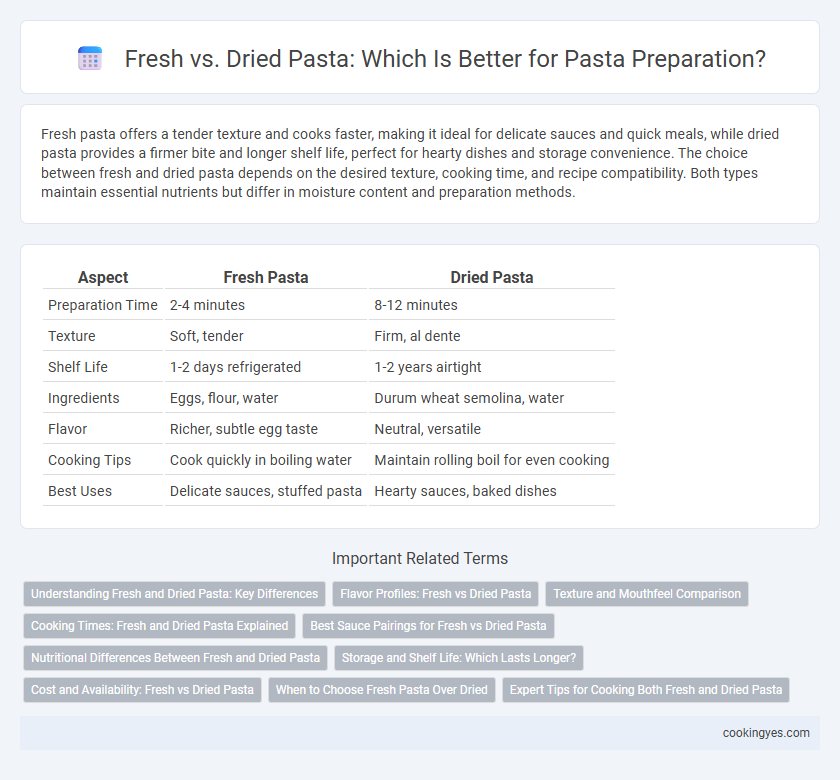Fresh pasta offers a tender texture and cooks faster, making it ideal for delicate sauces and quick meals, while dried pasta provides a firmer bite and longer shelf life, perfect for hearty dishes and storage convenience. The choice between fresh and dried pasta depends on the desired texture, cooking time, and recipe compatibility. Both types maintain essential nutrients but differ in moisture content and preparation methods.
Table of Comparison
| Aspect | Fresh Pasta | Dried Pasta |
|---|---|---|
| Preparation Time | 2-4 minutes | 8-12 minutes |
| Texture | Soft, tender | Firm, al dente |
| Shelf Life | 1-2 days refrigerated | 1-2 years airtight |
| Ingredients | Eggs, flour, water | Durum wheat semolina, water |
| Flavor | Richer, subtle egg taste | Neutral, versatile |
| Cooking Tips | Cook quickly in boiling water | Maintain rolling boil for even cooking |
| Best Uses | Delicate sauces, stuffed pasta | Hearty sauces, baked dishes |
Understanding Fresh and Dried Pasta: Key Differences
Fresh pasta, made from eggs and flour, has a tender texture and cooks quickly, typically within 2 to 4 minutes. Dried pasta, crafted from durum wheat semolina and water, boasts a longer shelf life and a firmer texture when cooked, usually requiring 8 to 12 minutes. Understanding these differences is essential for selecting the right pasta type to complement specific sauces and dishes.
Flavor Profiles: Fresh vs Dried Pasta
Fresh pasta offers a delicate, tender texture with a subtle eggy flavor that absorbs light sauces, enhancing nuanced taste experiences. Dried pasta provides a firm bite and a more pronounced wheat flavor, ideal for robust, hearty sauces that complement its al dente texture. The choice between fresh and dried pasta significantly influences the overall flavor profile and mouthfeel of the dish.
Texture and Mouthfeel Comparison
Fresh pasta offers a tender, silky texture with a delicate bite, creating a smooth and slightly chewy mouthfeel that absorbs sauces readily. Dried pasta provides a firmer, denser texture that holds shape well during cooking, resulting in a more al dente experience with a satisfying chew. The moisture content difference between fresh (around 30%) and dried pasta (typically 12%) significantly influences their cooking times and the final mouthfeel, making each ideal for different sauce pairings and culinary applications.
Cooking Times: Fresh and Dried Pasta Explained
Fresh pasta typically cooks in 2 to 4 minutes due to its higher moisture content and tender texture, making it ideal for quick meals and delicate sauces. Dried pasta requires longer cooking times, usually 8 to 12 minutes, as it is denser and needs more water absorption to reach the perfect al dente texture. Understanding these cooking durations helps achieve optimal pasta consistency and enhances flavor absorption in both fresh and dried varieties.
Best Sauce Pairings for Fresh vs Dried Pasta
Fresh pasta, with its tender texture and delicate flavor, pairs best with light sauces like olive oil, garlic, fresh herbs, and creamy sauces such as Alfredo or carbonara, which complement its subtle taste without overpowering it. Dried pasta's firm texture and robust bite hold up well to hearty, rich sauces like Bolognese, marinara, or chunky vegetable ragu, allowing the sauce to cling effectively to each strand or shape. Choosing the right sauce enhances the pasta experience, making fresh pasta ideal for nuanced flavors and dried pasta perfect for bold, substantial sauces.
Nutritional Differences Between Fresh and Dried Pasta
Fresh pasta contains higher moisture levels and slightly more protein due to its egg content, contributing to a softer texture and richer taste. Dried pasta offers a longer shelf life and typically has a higher carbohydrate concentration because of its lower moisture, making it a more calorie-dense option. Both fresh and dried pasta provide essential nutrients such as B vitamins and iron, but fresh pasta may retain more nutrients due to minimal processing.
Storage and Shelf Life: Which Lasts Longer?
Dried pasta has a significantly longer shelf life than fresh pasta, typically lasting up to two years when stored in a cool, dry place. Fresh pasta requires refrigeration and should be consumed within 2 to 3 days to maintain optimal texture and flavor. Proper storage conditions are crucial, with dried pasta benefiting from airtight containers to prevent moisture, while fresh pasta should be tightly wrapped to avoid drying out.
Cost and Availability: Fresh vs Dried Pasta
Fresh pasta typically costs more due to its perishable nature and limited shelf life, making it less widely available compared to dried pasta. Dried pasta offers greater affordability and longer storage, ensuring consistent availability in most grocery stores year-round. Cost-conscious consumers often prefer dried pasta for budget-friendly meals without sacrificing variety or quality.
When to Choose Fresh Pasta Over Dried
Fresh pasta is ideal for delicate sauces like cream or seafood-based ones, as its tender texture absorbs flavors more readily than dried pasta. Choose fresh pasta when cooking dishes requiring a shorter boiling time, typically less than three minutes, to preserve its soft, silky quality. For recipes emphasizing texture and bold sauces, dried pasta's firm bite and longer shelf life make it more suitable.
Expert Tips for Cooking Both Fresh and Dried Pasta
Fresh pasta cooks faster, typically in 1 to 3 minutes, and requires delicate handling to avoid overcooking and sticking; experts recommend using plenty of boiling salted water and immediate draining. Dried pasta benefits from longer cooking times, usually 8 to 12 minutes, with occasional stirring to prevent clumping, and achieving al dente texture by testing two minutes before the package time ends. For both types, reserving pasta water enhances sauce adherence, and finishing the pasta cooking in the sauce elevates flavor and texture.
Fresh vs dried for pasta preparation Infographic

 cookingyes.com
cookingyes.com